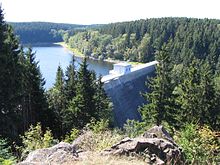Zillierbach Dam
| Zillierbach Dam | |
|---|---|
 |
|
|
Location of Zillierbach Dam in Germany
|
|
| Country | Germany |
| Location | Harz |
| Coordinates | 51°47′21″N 10°46′36″E / 51.78917°N 10.77667°ECoordinates: 51°47′21″N 10°46′36″E / 51.78917°N 10.77667°E |
| Construction began | 1934 |
| Opening date | 1936 |
| Dam and spillways | |
| Type of dam | Gravity dam |
| Impounds | Zillierbach |
| Height | 47 m (154 ft) |
| Length | 186 m (610 ft) |
| Width (crest) | 3.5 m (11 ft) |
| Dam volume | 54,000 m3 (1,900,000 cu ft) |
| Reservoir | |
| Total capacity | 2,830,000 m3 (100,000,000 cu ft) |
| Catchment area | 10.7 km2 (4.1 sq mi) |
The Zillierbach Dam (German: Zillierbachtalsperre) lies in the East Harz in the German state of Saxony-Anhalt near the town of Elbingerode (Harz) and impounds the Zillierbach stream. It supplies drinking water to several villages in the High Harz (Elbingerode, Elend (Harz), Schierke, teilweise Rübeland) as well as the town of Wernigerode; it also provides flood protection.
The Zillierbach was known as the Holtemme until the 16th century, then from 1558 as the Zilgerbach. Not until much later was it given its present name. Before the construction of the dam at Peterstein, it supplied the mills in Wernigerode and in the area around Halberstadt. Its variable water supply was evened out by an artificial ditch on the south side of the Hohneklippen, the Wormsgraben, built in the late 12th century.
The barrage is a concrete gravity dam. Initially it was intended to build an arch dam; but this was changed during construction. From 1998 to 2001 the dam was overhauled. In the middle of the wall is the valve house with its operating equipment.
The plan to build a dam first appeared in 1931. During the early phase of construction in 1934 cult artefacts from around the turn of the eras (AD 0) were found. The construction material was delivered from Drei Annen Hohne on a railway. The aggregate was extracted locally. A sawmill was built at the inlet to the reservoir just to provide wood for the dam casing. The cost was estimated beforehand at 3.31 million Reichsmarks. The bulk of the work was completed in June 1936. 54,500 m³ of casting mortar was used. In 1937 the waterworks below the dam was taken into service.
...
Wikipedia

